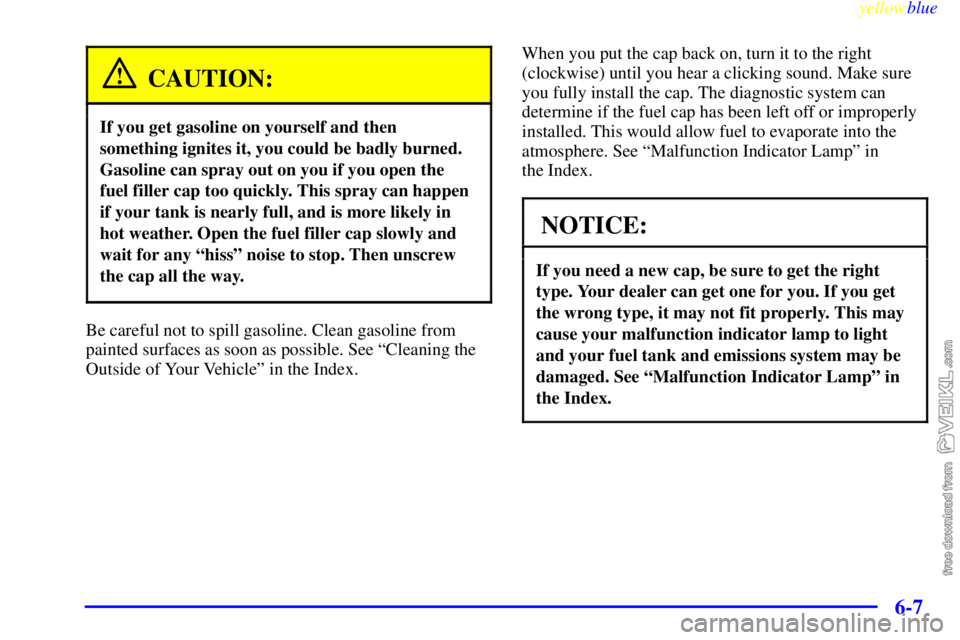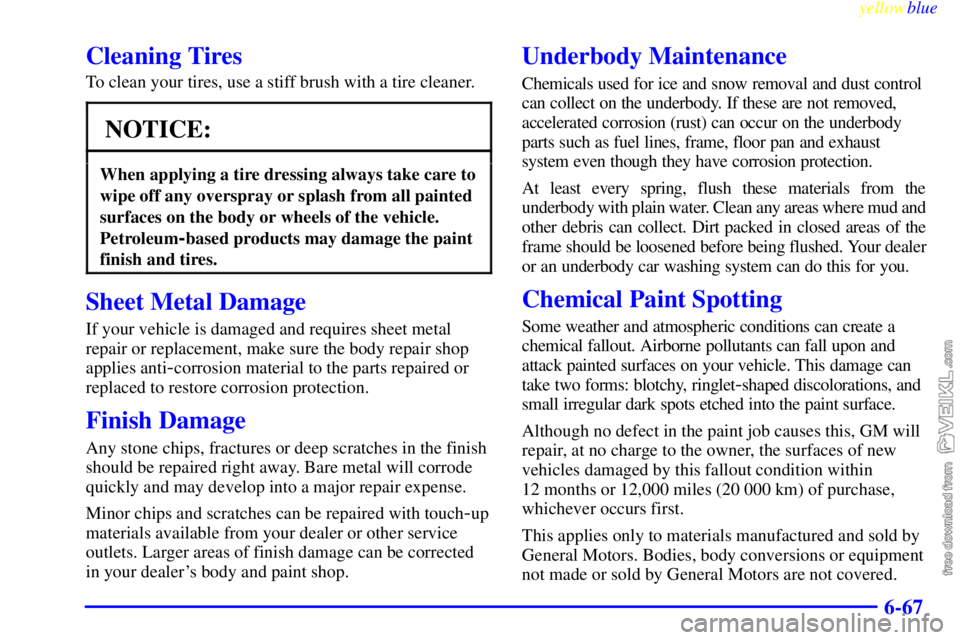Page 288 of 440
yellowblue
6-6
The fuel cap is located on the driver's side of
your vehicle.
Refuel the front tank first on a chassis
-cab model,
or in instances when only a partial fuel fill is desired.
An automatic transfer mechanism will maintain
approximately equal fuel levels in both tanks, so no
switching is required by the operator.
CAUTION:
Gasoline vapor is highly flammable. It burns
violently, and that can cause very bad injuries.
Don't smoke if you're near gasoline or refueling
your vehicle. Keep sparks, flames and smoking
materials away from gasoline.
While refueling, let the cap hang by the tether below the
fuel filler neck.
To remove the cap, turn it slowly to the
left (counterclockwise).
Page 289 of 440

yellowblue
6-7
CAUTION:
If you get gasoline on yourself and then
something ignites it, you could be badly burned.
Gasoline can spray out on you if you open the
fuel filler cap too quickly. This spray can happen
if your tank is nearly full, and is more likely in
hot weather. Open the fuel filler cap slowly and
wait for any ªhissº noise to stop. Then unscrew
the cap all the way.
Be careful not to spill gasoline. Clean gasoline from
painted surfaces as soon as possible. See ªCleaning the
Outside of Your Vehicleº in the Index.When you put the cap back on, turn it to the right
(clockwise) until you hear a clicking sound. Make sure
you fully install the cap. The diagnostic system can
determine if the fuel cap has been left off or improperly
installed. This would allow fuel to evaporate into the
atmosphere. See ªMalfunction Indicator Lampº in
the Index.
NOTICE:
If you need a new cap, be sure to get the right
type. Your dealer can get one for you. If you get
the wrong type, it may not fit properly. This may
cause your malfunction indicator lamp to light
and your fuel tank and emissions system may be
damaged. See ªMalfunction Indicator Lampº in
the Index.
Page 290 of 440

yellowblue
6-8
Filling a Portable Fuel Container
CAUTION:
Never fill a portable fuel container while it is in
your vehicle. Static electricity discharge from the
container can ignite the gasoline vapor. You can
be badly burned and your vehicle damaged if this
occurs. To help avoid injury to you and others:
�Dispense gasoline only into
approved containers.
�Do not fill a container while it is inside a
vehicle, in a vehicle's trunk, pickup bed or
on any surface other than the ground.
�Bring the fill nozzle in contact with the
inside of the fill opening before operating
the nozzle. Contact should be maintained
until the filling is complete.
�Don't smoke while pumping gasoline.
Checking Things Under the Hood
CAUTION:
If your vehicle has air conditioning, the auxiliary
engine fan under the hood can start up and
injure you even when the engine is not running.
Keep hands, clothing and tools away from any
underhood electric fan.
CAUTION:
Things that burn can get on hot engine parts and
start a fire. These include liquids like gasoline or
diesel fuel, oil, coolant, brake fluid, windshield
washer and other fluids, and plastic or rubber.
You or others could be burned. Be careful not
to drop or spill things that will burn onto a
hot engine.
Page 295 of 440

yellowblue
6-13
Among those acts presumed to constitute tampering are
the acts listed below.
Insulation:
�Removal of the noise shields or any
underhood insulation.
Engine:
�Removal or rendering engine speed governor
(if equipped) inoperative so as to allow engine speed
to exceed manufacturer specifications.
Fan and Drive:
�Removal of fan clutch (if equipped) or rendering
clutch inoperative.
�Removal of the fan shroud (if equipped).
Air Intake:
�Removal of the air cleaner silencer.
�Reversing the air cleaner cover.
Exhaust:
�Removal of the muffler and/or resonator.
�Removal of the exhaust pipes and exhaust
pipe clamps.Engine Oil (Gasoline Engine)
If your vehicle has a diesel engine, see ªEngine Oil
(Diesel Engine)º in the Diesel Engine Supplement.
It's a good idea to check your engine oil every time you
get fuel. In order to get an accurate reading, the oil must
be warm and the vehicle must be on level ground.
The engine oil dipstick has a yellow ring handle and is
located on the passenger's side of the engine.
Turn off the engine and give the oil several minutes to
drain back into the oil pan. If you don't, the oil dipstick
might not show the actual level.
Page 333 of 440
yellowblue
6-51 Inflation -- Tire Pressure
The Certification/Tire label, which is on the rear edge of
the driver's door, or on the incomplete vehicle document
in the cab, shows the correct inflation pressures for your
tires when they're cold. ªColdº means your vehicle has
been sitting for at least three hours or driven no more
than 1 mile (1.6 km).NOTICE:
Don't let anyone tell you that underinflation or
overinflation is all right. It's not. If your tires
don't have enough air (underinflation), you can
get the following:
�Too much flexing
�Too much heat
�Tire overloading
�Bad wear
�Bad handling
�Bad fuel economy.
If your tires have too much air (overinflation),
you can get the following:
�Unusual wear
�Bad handling
�Rough ride
�Needless damage from road hazards.
Page 349 of 440

yellowblue
6-67
Cleaning Tires
To clean your tires, use a stiff brush with a tire cleaner.
NOTICE:
When applying a tire dressing always take care to
wipe off any overspray or splash from all painted
surfaces on the body or wheels of the vehicle.
Petroleum
-based products may damage the paint
finish and tires.
Sheet Metal Damage
If your vehicle is damaged and requires sheet metal
repair or replacement, make sure the body repair shop
applies anti
-corrosion material to the parts repaired or
replaced to restore corrosion protection.
Finish Damage
Any stone chips, fractures or deep scratches in the finish
should be repaired right away. Bare metal will corrode
quickly and may develop into a major repair expense.
Minor chips and scratches can be repaired with touch
-up
materials available from your dealer or other service
outlets. Larger areas of finish damage can be corrected
in your dealer's body and paint shop.
Underbody Maintenance
Chemicals used for ice and snow removal and dust control
can collect on the underbody. If these are not removed,
accelerated corrosion (rust) can occur on the underbody
parts such as fuel lines, frame, floor pan and exhaust
system even though they have corrosion protection.
At least every spring, flush these materials from the
underbody with plain water. Clean any areas where mud and
other debris can collect. Dirt packed in closed areas of the
frame should be loosened before being flushed. Your dealer
or an underbody car washing system can do this for you.
Chemical Paint Spotting
Some weather and atmospheric conditions can create a
chemical fallout. Airborne pollutants can fall upon and
attack painted surfaces on your vehicle. This damage can
take two forms: blotchy, ringlet
-shaped discolorations, and
small irregular dark spots etched into the paint surface.
Although no defect in the paint job causes this, GM will
repair, at no charge to the owner, the surfaces of new
vehicles damaged by this fallout condition within
12 months or 12,000 miles (20 000 km) of purchase,
whichever occurs first.
This applies only to materials manufactured and sold by
General Motors. Bodies, body conversions or equipment
not made or sold by General Motors are not covered.
Page 356 of 440
yellowblue
6-74
Name Usage
ECM
-B Fuel Pump, PCM/VCM
RR DEFOG Rear Window Defogger
IGN
-E Auxiliary Fan Relay Coil,
A/C Compressor Relay,
Hot Fuel Module, Dual Tanks
HORN Horn, Underhood Lamps
AUX FAN Auxiliary FanName Usage
ECM
-1 Injectors, PCM/VCM, Fuel
Solenoid (Diesel Engine, Fuel
Control Module (Diesel Engine)
HTD ST
-FR Not Used
A/C Air Conditioning
HTD MIR Not Used
ENG
-1 Ignition Switch, EGR, Canister
Purge, EVRV Idle Coast Solenoid,
MAF, Heated O
2,
Fuel Heater (Diesel Engine),
Water Sensor (Diesel Engine),
Boost Solenoid (Diesel Engine),
EPR (Diesel Engine)
HTD ST
-RR Not Used
LIGHTING Headlamp and Panel Dimmer
Switch, Fog and Courtesy Fuses
BATT Battery, Fuse Block Busbar
IGN
-A Ignition Switch
IGN
-B Ignition Switch
ABS Anti
-Lock Brake Module
BLOWER High Blower Relay
STOP/HAZ Stoplamps
HEATED SEATS Not Used
Page 359 of 440

yellowblue
6-77 Cooling System Capacity (Approximate)
After refill, the level must be rechecked. See ªCooling
Systemº in the Index.
Engine VIN Quantity
ªVORTECº 5000 M 17.5 quarts (16.6 L)
ªVORTECº 5700 R 17.5 quarts (16.6 L)
ªVORTECº 7400 J 25.0 quarts (23.5 L)
ªVORTECº
7400 w/3500 HDJ 28.5 quarts (27.0 L)
Crankcase Capacity (Approximate)
After refill, the level must be rechecked. Add enough
engine oil so that the fluid is within the proper operating
range. See ªEngine Oilº in the Index.
Engine VIN
Quantity with Filter�
ªVORTECº 5000 M 5.0 quarts (4.8 L)
ªVORTECº 5700 R 5.0 quarts (4.8 L)
ªVORTECº 7400 J 6.6 quarts (6.3 L)
�Oil filter should be changed at every oil change.
Fuel Tank Capacity (Approximate)
Type Quantity
Short Bed 26 gallons (98 L)
Long Bed 34 gallons (128 L)
Standard Crew Cab 34 gallons (128 L)
Chassis
-Cab Front Tank 21 gallons (79 L)
Chassis
-Cab Rear Tank 18 gallons (68 L)
3500 HD Models Front Tank 21 gallons (79 L)
3500 HD Models Rear Tank 18 gallons (68 L)